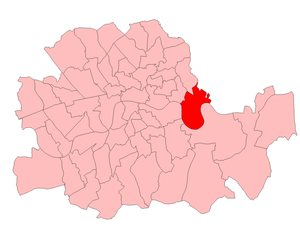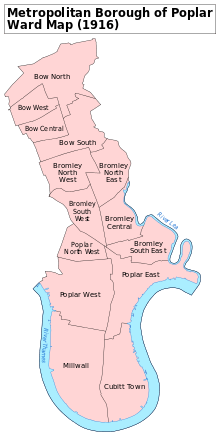Poplar South (UK Parliament constituency)
| South Poplar | |
|---|---|
|
Former Borough constituency for the House of Commons | |
| 1918–1950 | |
| Number of members | one |
| Replaced by | Poplar |
| Created from | Poplar |
Poplar South (strictly South Poplar, although this is an unusual form of official name for a borough constituency) was a parliamentary constituency centred on the Poplar district of the East End of London. It returned one Member of Parliament to the House of Commons of the Parliament of the United Kingdom.

Poplar South in the County of London, boundaries 1918-50
The constituency was created for the 1918 general election, and abolished for the 1950 general election. It was then largely replaced by a new Poplar constituency.
Boundaries

Poplar Metropolitan Borough ward boundaries in 1916
The Metropolitan Borough of Poplar wards of Bromley Central, Bromley South East, Poplar Cubitt Town, Poplar East, Poplar Millwall, Poplar North West, and Poplar West.
Members of Parliament
| Election | Member | Party | |
|---|---|---|---|
| 1918 | Alfred William Yeo | Liberal | |
| 1922 | Samuel March | Labour | |
| 1931 | David Adams | Labour | |
| 1942 by-election | William Guy | Labour | |
| 1950 | constituency abolished: see Poplar | ||
Election results
Elections in the 1910s
| Party | Candidate | Votes | % | ± | |
|---|---|---|---|---|---|
| Liberal | 8,571 | 49.4 | |||
| Labour | Samuel March | 4,446 | 25.6 | ||
| NFDDSS | Capt. Wilfrid T. Allen | 4,339 | 25.0 | ||
| Majority | 4,125 | 23.8 | |||
| Turnout | 36,077 | 48.1 | |||
| Liberal hold | Swing | N/A | |||
- endorsed by the Coalition Government
Elections in the 1920s
| Party | Candidate | Votes | % | ± | |
|---|---|---|---|---|---|
| Labour | Samuel March | 14,484 | 58.8 | ||
| National Liberal | Sir Alfred Yeo | 10,146 | 41.2 | ||
| Majority | 4,338 | 17.6 | |||
| Turnout | 37,026 | 66.5 | |||
| Labour gain from Liberal | Swing | +20.7 | |||
| Party | Candidate | Votes | % | ± | |
|---|---|---|---|---|---|
| Labour | Samuel March | 14,537 | 64.8 | +6.0 | |
| Liberal | Harold Heathcote-Williams | 7,899 | 35.2 | -6.0 | |
| Majority | 6,638 | 29.6 | +12.0 | ||
| Turnout | 37,681 | 59.5 | -7.0 | ||
| Labour hold | Swing | +6.0 | |||
| Party | Candidate | Votes | % | ± | |
|---|---|---|---|---|---|
| Labour | Samuel March | 16,224 | 62.6 | ||
| Liberal | Harold Heathcote-Williams | 9,709 | 37.4 | ||
| Majority | 6,515 | 25.2 | |||
| Turnout | 38,336 | 67.6 | |||
| Labour hold | Swing | -2.2 | |||
| Party | Candidate | Votes | % | ± | |
|---|---|---|---|---|---|
| Labour | Samuel March | 19,696 | 64.8 | +2.2 | |
| Liberal | Harold Heathcote-Williams | 7,185 | 23.6 | -13.8 | |
| Unionist | Elliot Marcet Gorst | 3,532 | 11.6 | n/a | |
| Majority | 12,511 | 41.2 | +16.0 | ||
| Turnout | 47,845 | 63.6 | -4.0 | ||
| Labour hold | Swing | +8.0 | |||
Elections in the 1930s
| Party | Candidate | Votes | % | ± | |
|---|---|---|---|---|---|
| Labour | David Morgan Adams | 16,253 | 57.6 | ||
| Liberal | Herbert L.M. Jones | 11,965 | 42.4 | ||
| Majority | 4,288 | 15.2 | |||
| Turnout | 48,166 | 58.6 | |||
| Labour hold | Swing | -13.0 | |||
| Party | Candidate | Votes | % | ± | |
|---|---|---|---|---|---|
| Labour | David Morgan Adams | 18,715 | 73.2 | ||
| Conservative | Mrs. Diana V.C.E. Spearman | 6,862 | 26.8 | ||
| Majority | 11,853 | 46.4 | |||
| Turnout | 46,231 | 55.3 | |||
| Labour hold | Swing | N/A | |||
Elections in the 1940s
| Party | Candidate | Votes | % | ± | |
|---|---|---|---|---|---|
| Labour | William Henry Guy | 3,375 | 86.2 | ||
| Christian Socialist | Rev. P.H. Figgis | 541 | 13.8 | ||
| Majority | 2,834 | 72.4 | |||
| Turnout | 42,034 | 9.3 | |||
| Labour hold | Swing | N/A | |||
| Party | Candidate | Votes | % | ± | |
|---|---|---|---|---|---|
| Labour | William Henry Guy | 11,620 | 89.2 | ||
| Conservative | Joan Helen Vickers | 1,403 | 10.8 | ||
| Majority | 10,217 | 78.4 | |||
| Turnout | 19,667 | 66.2 | |||
| Labour hold | Swing | N/A | |||
References
This article is issued from Wikipedia - version of the 10/9/2015. The text is available under the Creative Commons Attribution/Share Alike but additional terms may apply for the media files.